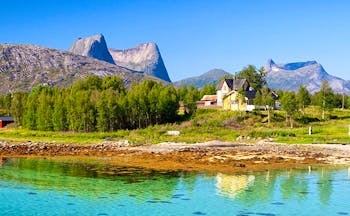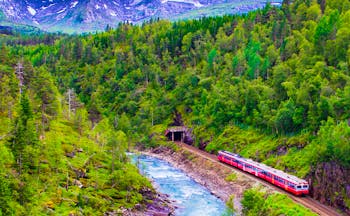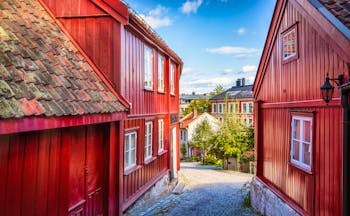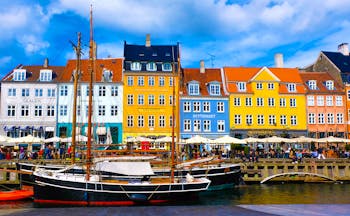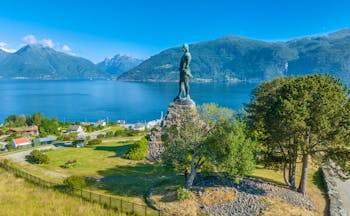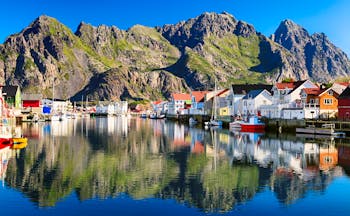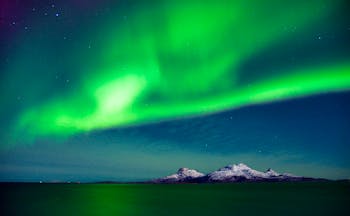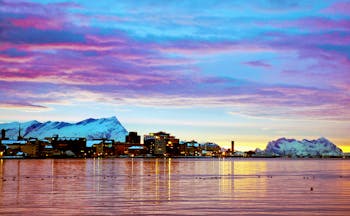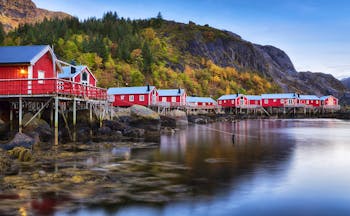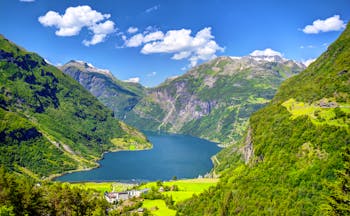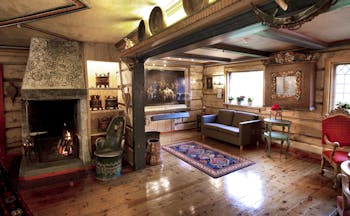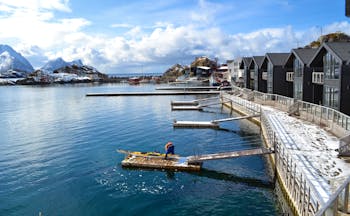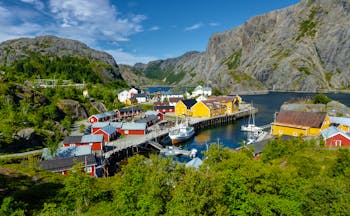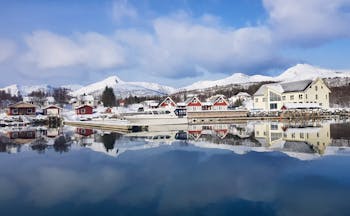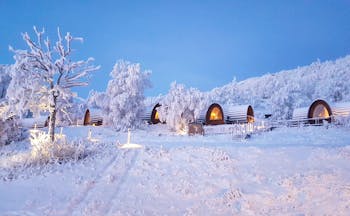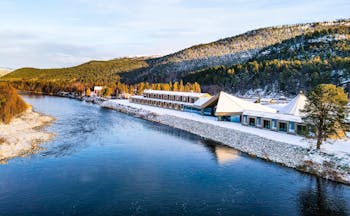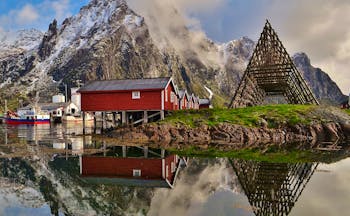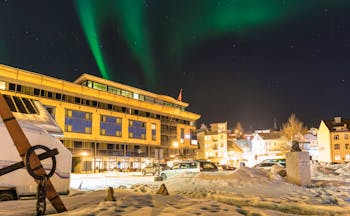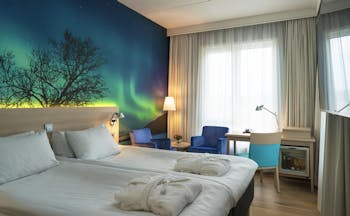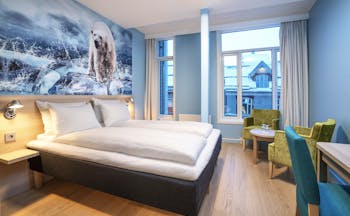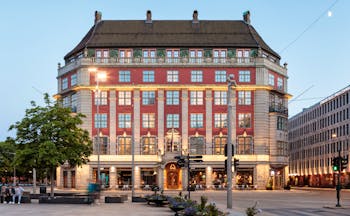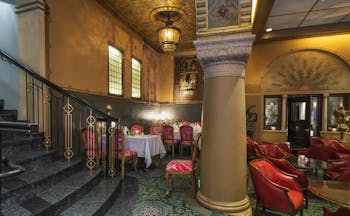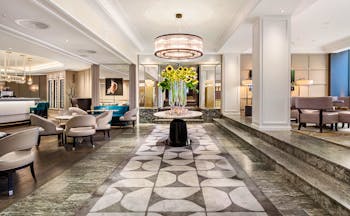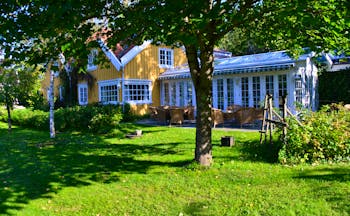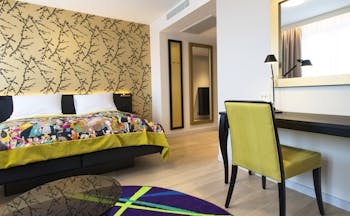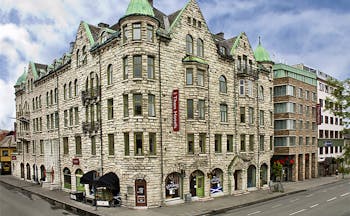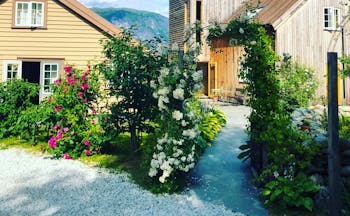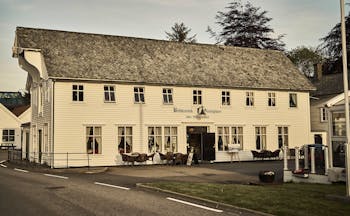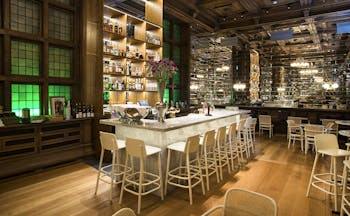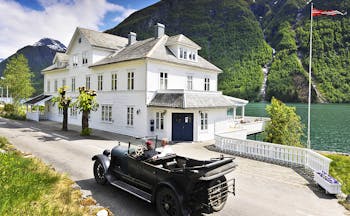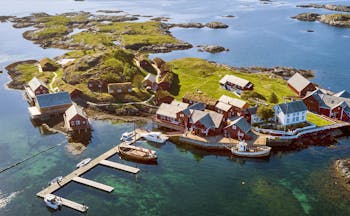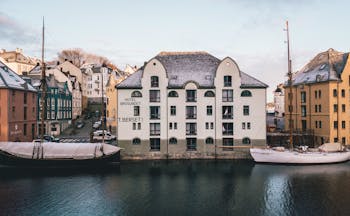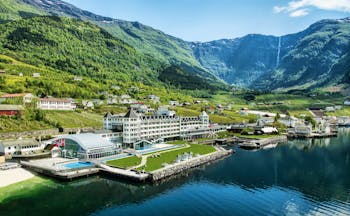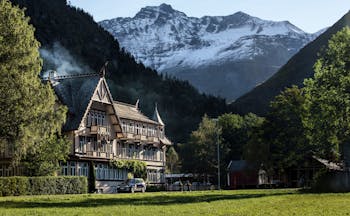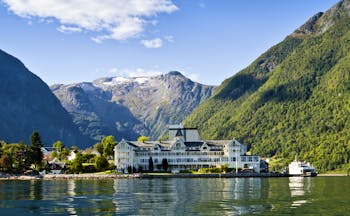Luxury hotel holidays to Norway, bespoke tours and holidays to Norway by air, car, boat and train.
Norway, land of the fjords, the Northern Lights, Viking heritage and Sami culture, is a fascinating destination for a luxury, tailor-made holiday. The land and the culture of Norway lend themselves to a diverse and rich array of holiday experiences and a choice of mode of transport.
Norway offers magnificent, dramatic, severe and wild natural surroundings in its glaciers, Arctic snow and ice, majestic fjords, crashing waterfalls and mystical natural phenomena such as the Aurora Borealis (the Northern Lights) and Fata Morgana.
However, Norway also offers cultural ties, a shared history dating from the days of the Vikings, a cosiness in its orchards and pastures, brightly painted wooden houses, folk tales and mythology, world-class art, literature and music in the works of Munch, Ibsen and Grieg, to name but three, and international philanthropy as exemplified by the Nobel prize. Many towns have superb museums, ancient wooden stave churches are well-preserved, the heritage of the Vikings is visible not just in major centres such as Oslo but all around, and seemingly small places are rich with music and drama festivals. Norway’s cities are vibrant and manage to blend modernity with tradition. The iconic Oslo Opera House sits a short distance from the Akershus fortress, the Old Town Hall dating from 1641 is a stroll away from the Akrobaten pedestrian bridge, a near-futuristic construction of steel and glass.
Whilst the length of Norway with its 2518 kms from north to south poses a challenge to the visitor, this also means that it makes sense to use a variety of transport modes to travel around; scenic trains, sleeper trains, boat rides, coastal cruises and car-hire can all be incorporated. Making these inter-connected, complex transport arrangements and combining them with stays in authentic, regional hotels is part of the professional service offered and provided by Expressions Holidays.
The landscape lends itself affords many outstanding opportunities on land and on the water for activities and unique experiences. Cycling and hiking are possible throughout the country, but there are opportunities to try your hand at activities such as sea kayaking, glacier walking, moose tracking with a guide, ice fishing, sea fishing, sledding with huskies, snowshoe walking and cross-country skiing.
Our bespoke, luxury hotel holidays can be
● Single centre or multi-centre● Long or short stays
● Combine a variety of different hotels in different regions
● Utilise a variety of transport arrangements to and within Norway including flights, ferries, overnight ferries, trains and hire-car
Included in all our holidays
● Concierge service● Handcrafted helpful hints and local information provided with all our holidays
● Personal service by your sales consultant who looks after all aspects of your holiday
● Full financial protection with our ATOL (3076) for all holidays including a flight and our ABTOT for all non-air holidays
Call us on 01392 441245
Luxury hotel holidays to Norway, bespoke tours and holidays to Norway by air, car, boat and train.
Our Hotels
Each hotel in Norway featured by Expressions Holidays has been selected to deliver exceptionally high standards of comfort, service and cuisine. Many of our luxury hotels are among the most highly acclaimed in Norway. Some have more local or rustic charm and character, but all are authentic and typical of their region. Although most of our portfolio of hotels tend to be 4-star hotels, each hotel has unique qualities and an authentic individuality. We offer you a choice of room types at each hotel, so whilst the sample prices we quote are usually just based on a standard or entry-level room, we can offer you upgraded rooms, junior suites and suites. In Norway, we almost always include bed and breakfast in the basic holiday price but if the hotel offers half board, then we can offer you half board at a supplement. Some hotels include all meals and activities, particularly in the Arctic resorts.
Travel
The travel options we provide reflect the diversity of our holidays to Norway. Most of our holidays will start with a flight to Oslo or another regional city. Within Norway we recommend a mixture of train services, the Hurtigruten coastal ferry service and hire-car for exploring in more depth Within Norway, and part of its attraction is this, there are many different travel options, and we find that most of our holidays will consist of several types of travel within Norway.
By air
There are direct flights to Oslo, Bergen, Trondheim, Alesund and Tromsø, from London and some other UK airports, although some are seasonal. Otherwise for all other Norwegian regional airports you can fly via Oslo or Bergen or Trondheim. There are many domestic flights making it easy to combine regions such as Vestlandet and Northern Norway, or Oslo and the Lofoten islands.
By rail
The train network is excellent throughout southern Norway and is a good option for getting from Oslo to Bergen. Just off the Oslo to Bergen route is the Flåmsbana from Myrdal to Flåm on the Sognefjord. There is also a direct train from Oslo to Trondheim which takes about 7 hours. From Trondheim to Bodø within the Arctic Circle there is the Nordland scenic train, a journey of about 10 hours. North of Bodø there is not a railway network as such, although there is a sleeper train from Narvik via Kiruna in Sweden to Stockholm. It is also possible to travel to Norway from the UK by train. We recommend about three overnight stops on the way, and it makes sense to break the journey in Cologne, Hamburg and Copenhagen. You can always take the train one way and fly the other.
By boat
The Hurtigruten line is one of the most famous and covers the coastal distance from Bergen to Kirkenes (over 2,500 kms) with 34 stops. Bergen to Kirkenes takes seven days and you can choose from a variety of cabins on board. We recommend that you do part of the journey by boat, perhaps Bergen to Trondheim, which takes 3 days, or Bodø to Svolvaer in the Lofoten Islands which can be done within one day. You can time your voyage to do parts of it by day and parts overnight. There are also ferries along the fjords, for example from Bergen to Flåm along the Sognefjord, which takes about five hours. There is also the Havila coastal voyages that cover the route from Bergen to Kirkenes, also with 34 stops. You can travel on day-time services or on longer journeys overnight with a comfortable cabin. Havila operate new ships and pride themselves on being the most sustainable including four hours' sailing with zero emissions, heat recovery from the sea and engines, NOx emissions reduced by 90% and using charging current on the quay from hydropower. Cabins reflect Nordic standards of decoration and most have sea views. All cabins have Wi-Fi and USB ports. Superior and deluxe cabins and suites have double beds. Panoramic cabins have floor-to-ceiling windows. If taking a longer journey along the coast, the Havila ship docks in a port for a few hours so you can disembark and experience the town.
Hire-car
To explore within an area or to cover parts of the country, it’s recommended to have the use of a hire-car. Roads in Norway are good, and you will need to board ferries for many routes. In fact, over 100 public roadways require cars to board a ferry. You don’t book ahead for these but you need to allow for extra time but this is part of the charm of driving yourself around Norway.
Our bespoke, luxury hotel holidays can be
● Single centre or multi-centre● Long or short stays
● Combine a variety of different hotels in different regions
● Utilise a variety of transport arrangements to and within Norway including flights, ferries, overnight ferries, trains and hire-car
Included in all our holidays
● Concierge service● Handcrafted helpful hints and local information provided with all our holidays
● Personal service by your sales consultant who looks after all aspects of your holiday
● Full financial protection with our ATOL (3076) for all holidays including a flight and our ABTOT for all non-air holidays
Call us on 01392 441245
Luxury hotel holidays to Norway, bespoke tours and holidays to Norway by air, car, boat and train.
Norway is a fascinating destination for a luxury, tailor-made holiday. The land and the culture of Norway lend themselves to a diverse and rich array of holiday experiences and a choice of mode of transport. At first glance, Norway offers magnificent, dramatic, severe and wild natural surroundings in its glaciers, Arctic snow and ice, majestic fjords, crashing waterfalls and mystical natural phenomena such as the Aurora Borealis and Fata Morgana. However, Norway also offers cultural ties, a shared history dating from the days of the Vikings, a cosiness in its orchards and pastures, brightly-painted wooden houses, folk tales and mythology, world-class art, literature and music in the works of Munch, Ibsen and Grieg, to name but three, and international philanthropy as exemplified by the Nobel prize. Many towns have superb museums, ancient wooden stave churches are well-preserved, the heritage of the Vikings is visible not just in major centres such as Oslo but all around, and seemingly small places are rich with music and drama festivals. Whilst the length of Norway with is 2518 km poses a challenge to the visitor, this also means that it makes sense to use a variety of transport modes to travel around; scenic trains, sleeper trains, boat rides, coastal cruises and car-hire can all be incorporated. The landscape lends itself well to hiking and cycling and there are many national parks that offer a variety of conditions depending on your ability. Norway’s cities are vibrant and manage to blend modernity with tradition. The iconic Oslo Opera House sits a short distance from the Akershus fortress, the Old Town Hall dating from 1641 is a stroll away from the Akrobaten pedestrian bridge, a near-futuristic construction of steel and glass.
Norway
Capital
Oslo
Airports
Oslo Gardermoen
Currency
Norwegian Krone
Size
323,878 sq km
Population
4.4 million
Average temperature
The climate in Norway is relatively temperate considering its latitude. This is because of the influence of the Gulf Stream which keeps the north Atlantic and Arctic oceans free of ice in the winter and it warms the westerly and southwesterly winds that blow in from the sea. Average summer temperatures are about 16C in the south(although they can be double that) and about 13C in the north. In the winter the average temperature in the south is 1c and in the north -1C. Bergen attracts the most rainfall, with Gudbrandesdal and Rondane amongst the driest areas.
National holidays
1 January, Good Friday and Easter Sunday, 1 May, 17 May, Ascension Day and Whitsunday, Christmas Day

















